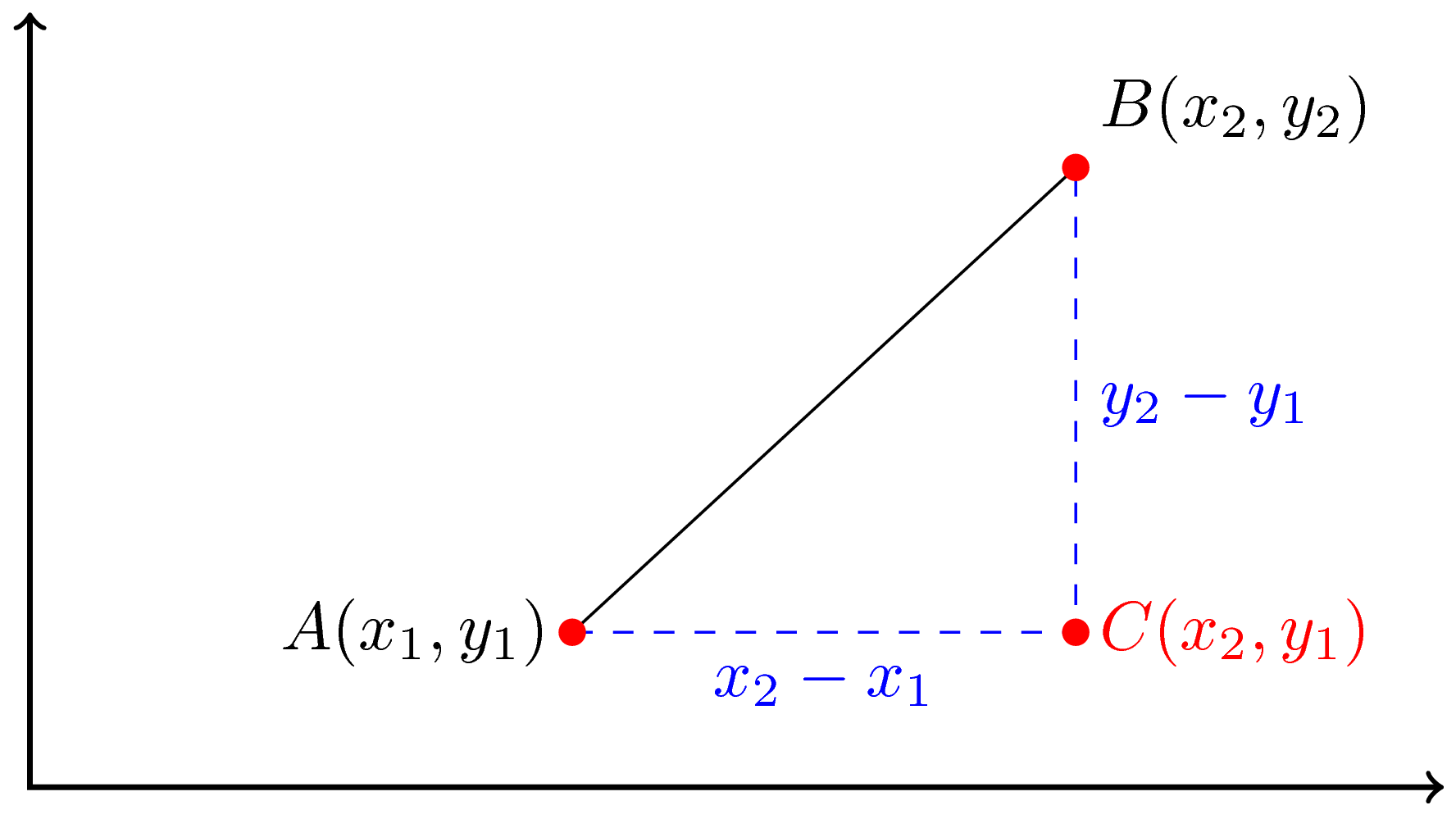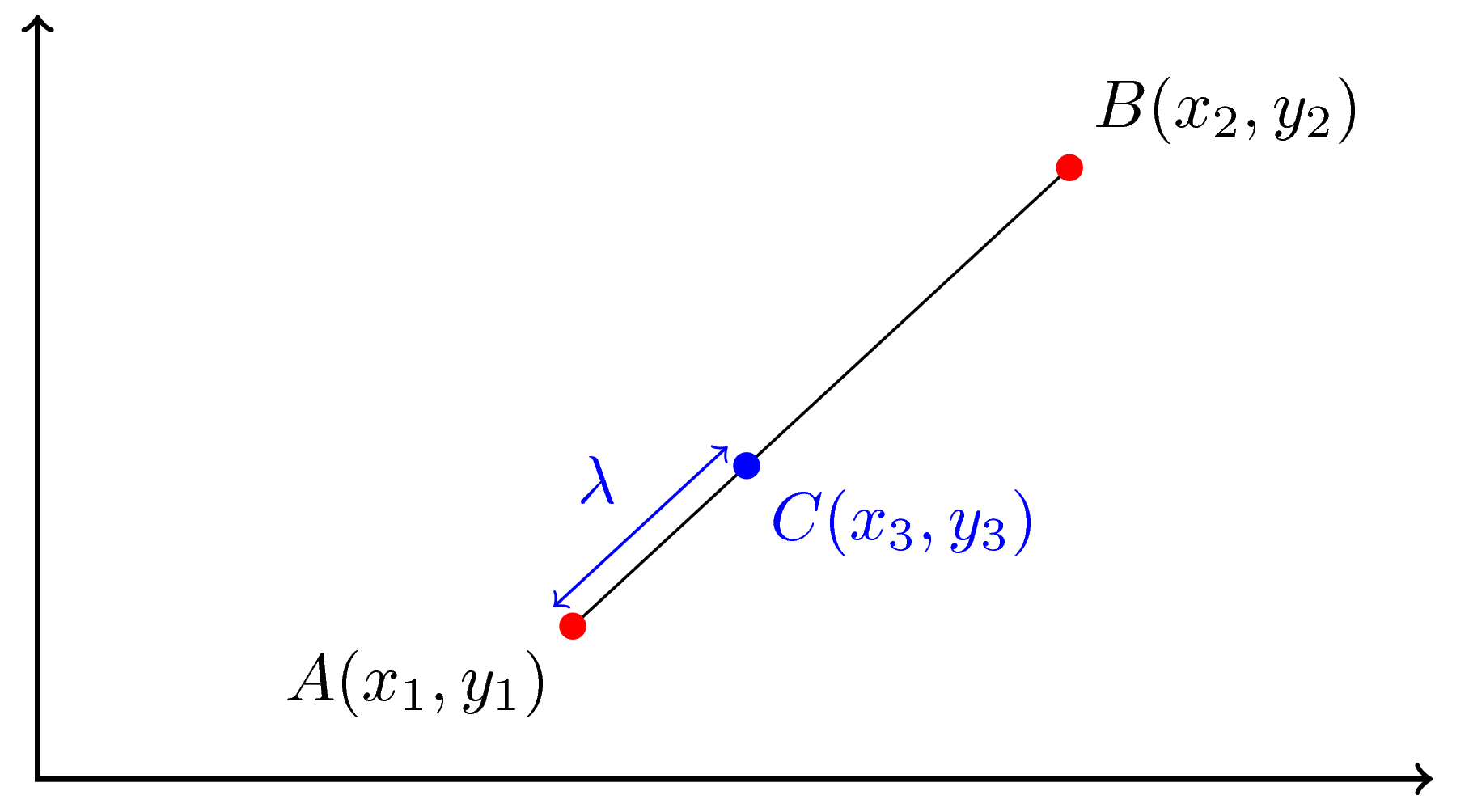Properties of Straight Line Segments
Distance Between Two Points
Definition
Two points $A(x_1,y_1)$ and $B(x_2,y_2)$ can be joined to form a line segment. Taking this length as the hypotenuse of a right angled triangle ABC, the length of this line segment is found using Pythagoras' Theorem.

|400px|center
\[AB^2=AC^2+BC^2\text{.}\]
This can be written more generally in terms of coordinates:
\[AB = \sqrt{(x_2-x_1)^2+(y_2-y_1)^2}\text{.}\]
Worked Example
Example 1
Given the points $A(1,3)$ and $B(4,5)$, find the length $AB$.
Solution
\begin{align} AB &= \sqrt{(x_2-x_1)^2+(y_2-y_1)^2}\\\\ &=\sqrt{(4-1)^2+(5-3)^2}\\\\ &=\sqrt{3^2+2^2}\\\\ &=\sqrt{9+4}\\\\ &=\sqrt{13} \end{align}
Point on a Line
Definition
Two points $A(x_1,y_1)$ and $B(x_2,y_2)$ are joined by a line, and we wish to find a third point $C(x_3,y_3)$ on this line which is $\lambda$ units away from $A$.

|400px|center
First find the length of the line segment $AB$ (see above), then find the segment ratio: $\lambda$ as a fraction of the length of $AB$: \[r = \frac{\lambda}{AB}\].
The point $C$ is at $A+r(B-A) = (1-r)A + rB$, so its coordinates are \begin{align} x_3 &= r \times x_1 + (1 - r) \times x_2 \\ y_3 &= r \times y_1 + (1 - r) \times y_2 \end{align}
Worked Example
Example 1
Given the points $A(-2,3)$ and $B(1,7)$ find the point $C$ which lies $2$ units away from $A$ on the line $AB$.
Solution
Find the length of the line segment $AB$. \begin{align} AB &= \sqrt{(x_2-x_1)^2 + (y_2-y_1)^2}\\ &=\sqrt{\bigl(1-(-2)\bigr)^2+(7-3)^2}\\ &=\sqrt{9+16}\\ &=\sqrt{25}\\ &=5 \end{align}
Next find $\lambda$ as a fraction of the length $AB$. \begin{align} r &= \frac{\lambda}{AB}\\ &=\frac{2}{5} \end{align}
Now we can find the coordinates of $C$. \begin{align} x_3 &= r \times x_1 + (1 - r) \times x_2\\ &=\frac{2}{5}\times(-2) + \left(1-\frac{2}{5}\right) \times 1\\ &=-\frac{4}{5}+\frac{3}{5}\\ &=-\frac{1}{5} \end{align}
\begin{align} y_3 &= r \times y_1 + (1 - r) \times y_2\\ &=\frac{2}{5}\times 3 + \left(1-\frac{2}{5}\right) \times 7\\ &=\frac{6}{5} + \frac{21}{5}\\ &=\frac{27}{5} \end{align}
So the coordinates of point $C$ are $\left(-\dfrac{1}{5}, \dfrac{27}{5}\right)$.
Midpoint
Definition
The midpoint $P$ of a line joining two points $A(x_1,y_1)$ and $B(x_2,y_2)$ is half way between the two points. The formula is derived from the “point on a line” formula given above, when $r=\frac{1}{2}$/
\[P=\left(\frac{1}{2}(x_1+x_2),\frac{1}{2}(y_1+y_2)\right)\]
Worked Example
Example 1
Find the midpoint $P$ of a line $AB$, where $A(2,-2)$ and $B(-4,3)$.
Solution
\begin{align} P&=\left(\frac{1}{2}(x_1+x_2),\frac{1}{2}(y_1+y_2)\right)\\ &=\left(\frac{1}{2}\Bigl(2+(-4)\Bigr),\frac{1}{2}\Bigl((-2)+3\Bigr)\right)\\ &=\left(\frac{1}{2}(-2),\frac{1}{2}(1)\right)\\ &=\left(-1,\frac{1}{2}\right) \end{align}
Video Example
Hayley Bishop finds the length and midpoint of the line segment between $A(-2,1)$ and $B(3,0)$.
Workbook
This workbook produced by HELM is a good revision aid, containing key points for revision and many worked examples.
- The straight line including worked examples on the distance between two points.
External Resources
- Properties of straight line segments workbook at mathcentre.